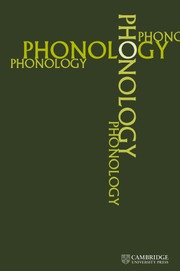Article contents
Transparency in Hungarian vowel harmony*
Published online by Cambridge University Press: 20 October 2008
Extract
Phonologists have known for some time that the so-called ‘standard’ theory of generative phonology is not adequate for the analysis of vowel harmony. Ringen (1975, 1977, 1980) suggests that some of the problems can be solved by abandoning the assumption that phonological representations are fully specified. Clements (1977b, 1980) suggests that vowel harmony should be analysed autosegmentally. Underspecification theory, developed in the recent work of Kiparsky, Archangeli and Pulleyblank, incorporates both of these proposals. This paper considers how Hungarian can be analysed within this theory. It is shown that by adopting Goldsmith's (1985) proposal that vowel harmony in Hungarian involves the spreading of the feature [−back], the transparent (neutral) vowels in Hungarian are derived because the redundancy rule assigning [−back] to these vowels, although available, does not apply early in the derivation because its structural description is not met.
- Type
- Articles
- Information
- Copyright
- Copyright © Cambridge University Press 1988
References
REFERENCES
- 16
- Cited by


